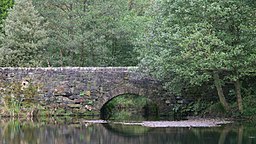Bentley Brook
| Bentley Brook | |
| River | |
|
Bridge carrying Oaksedge Lane over Bentley Brook as it enters the reservoir
|
|
| Country | England |
|---|---|
| Region | Derbyshire |
| Source | |
| - location | Matlock Moor, England |
Bentley Brook is a stream located in Derbyshire, England. It rises on Matlock Moor, flowing south through Cuckoostone Dale, under the A632, into Lumsdale, gathering the valley's waters—notably from Knabhall Brook, out of Tansley, itself dammed and supporting large mills. In Lumsdale it enters a now disused mill pond or reservoir, then flows over a waterfall in the course of passing several historical mill ruins. Finally, it runs through control gates into the outside bend of a tight oxbow of the River Derwent, just beyond Hall Leys Park in Matlock. Although only about five miles in length, Bentley Brook is classed as a 'main river' by the Environment Agency.
The Brook, formerly called "Lums", flows through the wooded gorge of Lumsdale Valley and is notable for being the site of six now disused water wheels and three mill ponds - "perhaps the most concentrated evidence of early water power in Great Britain." The power of the stream was harnessed by generations of mills in the valley, operating over several centuries. In now overgrown ruins, Bone Mill can be dated to the 16th century, and was used to grind animal bones for fertiliser up to the 1920s. Its wheel pit still remains, as does the tailrace leading back into Bentley Brook. Past the Pond Cottages (originally for lead smelting) and a footbridge is a picturesque pond, held by the Lower Dam, which was built in 1830 to harness the Brook. This stone-lined reservoir features a central drain plug. From high on its dam wall, a still-visible metal pipe conducted water to the wheel of the adjacent, second mill, dating from 1850, and still functioning as a sawmill at the turn of the 20th century. Visible below that and near the path, is a millstone imported from the Massif Central in France, originally in six sections bound in iron. Next below, now following steps and viewing platforms provided by the Arkwright Society in 1989, is "Paint Mill", mainly used to grind white barytes for the paint industry, which has been largely preserved by the Arkwright Society. It was also used to smelt lead, grind corn and bleaching. The fourth mill, beside the Brook's largest waterfall, dates from the 1770s and was used to grind corn and minerals.
...
Wikipedia

